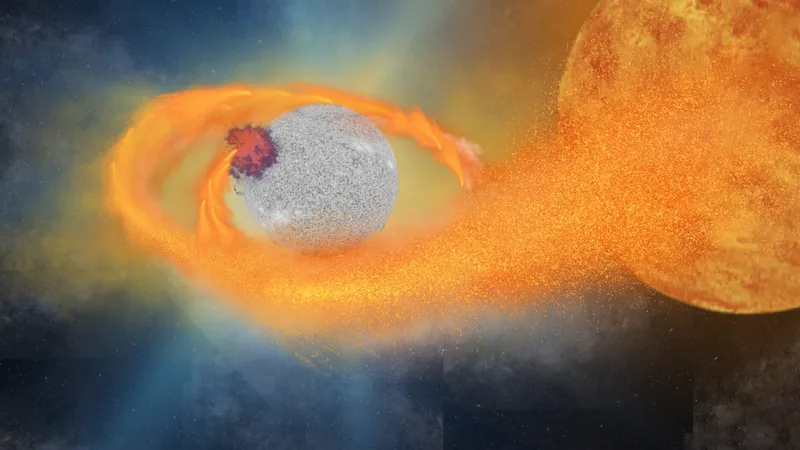
The 'Vampire Star' on a Collision Course with Cosmic Oblivion: What You Need to Know!
2025-01-10
Author: Ying
Prepare to be astounded! In an incredible twist of stellar fate, a rapidly spinning white dwarf star—dubbed the "vampire star"—is not only devouring matter from a companion star, it is also on the brink of a cataclysmic explosion! While this might sound like a plot twist from a sci-fi drama, it is very much a reality that astronomers are racing to decode.
Located approximately 1,700 light-years from Earth, this extraordinary white dwarf goes by the designation RX J0648.0-4418 and is part of a binary star system with the star HD 49798. This duo has been of interest to astronomers since 1997 when it was detected emitting curious X-rays. Fast forward to 2009, and the European Space Agency's XMM-Newton telescope confirmed RX J0648.0-4418's identity as a white dwarf star, which has since gained notoriety for its astonishing rotational speed—spinning around once every 13 seconds, making it the fastest in its class!
But hold your horses—what's causing this star's crazy spin? It turns out that RX J0648.0-4418 is not just "feeding" off its stellar partner; it is also shrinking! This combination of accretion (the technical term for matter consumption) and ongoing contraction generates an increase in the white dwarf's rotational velocity—not merely due to the mass intake, but because the object itself is getting smaller!
Research spearheaded by Sandro Mereghetti from the National Institute of Astrophysics has unraveled some of its mysteries, explaining that the spin-up rate of the star cannot be accounted for by mere mass intake alone. Previous binary systems observed don't share the same unique characteristics, making RX J0648.0-4418 an exceptionally rare find. Its companion star is a highly evolved, helium-burning hot subdwarf star—unlike anything else scientists have encountered in similar systems.
Now, about its explosive destiny: RX J0648.0-4418 is not only one of the fastest-spinning white dwarfs ever seen but also extraordinarily massive, weighing in at 1.2 times the mass of our Sun. This is tantalizingly near the Chandrasekhar limit of 1.4 solar masses—the threshold where a white dwarf can no longer sustain itself and inevitably undergoes a supernova explosion. Estimates suggest that this dramatic event could occur in less than 100,000 years—a mere blink of an eye in cosmic terms!
Mereghetti noted that as its companion star evolves and expands, the rate at which the white dwarf consumes material is expected to increase, further hastening its fiery farewell. This latter development only adds urgency for astronomers to unravel the tender complexities surrounding this unique binary system.
As RX J0648.0-4418 inches closer to its supernova fate, future observations are vital for unlocking its secrets. Enhanced X-ray telescopes are expected to provide further insights—all while increasing curiosity about the nature of stellar evolution in our universe.
Mark your calendars, folks! The cosmic drama unfolding in this faraway duo serves as a reminder that while stars might appear charming in the night sky, their lives can often take explosive turns, leaving behind mystery and wonder for generations of astronomers to explore.

 Brasil (PT)
Brasil (PT)
 Canada (EN)
Canada (EN)
 Chile (ES)
Chile (ES)
 Česko (CS)
Česko (CS)
 대한민국 (KO)
대한민국 (KO)
 España (ES)
España (ES)
 France (FR)
France (FR)
 Hong Kong (EN)
Hong Kong (EN)
 Italia (IT)
Italia (IT)
 日本 (JA)
日本 (JA)
 Magyarország (HU)
Magyarország (HU)
 Norge (NO)
Norge (NO)
 Polska (PL)
Polska (PL)
 Schweiz (DE)
Schweiz (DE)
 Singapore (EN)
Singapore (EN)
 Sverige (SV)
Sverige (SV)
 Suomi (FI)
Suomi (FI)
 Türkiye (TR)
Türkiye (TR)
 الإمارات العربية المتحدة (AR)
الإمارات العربية المتحدة (AR)